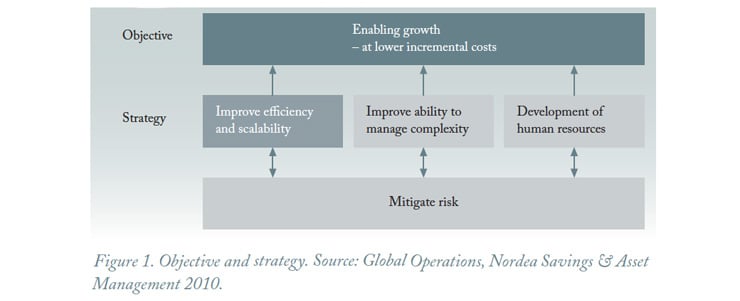

BEST PRACTICE IN COST MANAGEMENT FROM SCANDINAVIA'S LEADING ASSET MANAGER
Client story
To rely on operating a wall-to-wall IT solution has been a key element in the successful attempt to reduce costs at Nordea Savings & Asset Management.
By Ulrik Modigh, COO at Nordea Savings & Asset Management
With around USD 318 billion in assets under management, Nordea Savings & Asset Management (S&AM) is the leading Nordic asset manager, providing products and competence within equities, fixed-income products, alternative investments and other savings products.
With a presence in the Nordic countries, New York, London, Frankfurt and Luxembourg, S&AM is one of five business divisions within the business area Shipping, Private Banking & Savings Products. Comprising part of Nordea S&AM is the Global Operations business area. Employing approximately 150 fulltime employees, Global Operations includes all back- and middle-office functions as well as fund accounting, transfer agency, IT and business processes.
Strategic tool
Since 2006, Global Operations has focused work on cost management as a strategic tool to ensure that Nordea S&AM has a favorable cost position compared to its peers. The strategy has been to emphasize centralization and standardization of operational processes, implementing operational key performance indicators (KPIs) to increase efficiencies, as well as to establish transparency in operational costs.
Despite higher volumes and increased complexity in business demands during this timeframe, Nordea S&AM has succeeded in reducing the operational cost base as a whole. In doing so, Nordea S&AM has compared its operational costs against other asset management companies in an annual benchmark study and has been able to effectively learn from other companies’ best practices.

The entire cost management strategy has relied on the fact that Global Operations operates with SimCorp Dimension’s wall-to-wall system, which provides the ability to implement a global operational strategy. The system as such has been the foundation for rolling out the strategy in relation to centralization of activities, standardization of activities and automation.
One of the cornerstones of Global Operations’ strategy is cost management. The strategy consists of four building blocks, altogether supporting the objective of enabling growth at lower incremental costs to support S&AM’s overall business strategy.
Strategy review
As the starting point for developing the strategy, an external consultancy company was asked to undertake an independent strategy review of Global Operations’ IT platform and operational processes/strategy. The purpose of the review was to investigate how to optimize the operating model, as well as to exploit the potential for economies of scale and increase efficiencies within operational processes. The outcome of the strategy review produced a clear indication of the relative cost position compared to peers and recommendations on how to focus in order to maintain and improve the cost position.
The review found that to date, Global Operations’ IT and operational strategy had resulted in an attractive and competitive cost position vis-à-vis most of its peers. The very best players provided some inspiration for further improvements, and it was important for Global Operations to build a consolidated and transparent cost view. Second, Global Operations had had more success in moving towards a single IT platform than many other large asset managers. Finally, not that many other asset managers could boast lower IT and operational costs.
It was further recommended that Global Operations’ strategy should include the following key initiatives to support the cost-related business strategy going forward:
- Centralize and standardize Global Operations’ processes (also covering a central solution for derivatives and risk management)
- build transparency into Global Operations’ costs
- establish Luxembourg as strategic domicile to reduce average running costs
Implementing standardization
Acting on the findings, Global Operations has focused its efforts in line with the specific recommendations. Significant synergies have been realized through decommissioning old local platforms and centralizing into focused competence centers. Global Operations has established an operating model where Nordea’s entire Investment Management/Investment Funds value chain is covered by the same platform – hence no overlapping routines such as reconciliation, corporate actions, static data, pricing, risk, etc. The centralization activities have covered:
- Implementing a derivatives strategy. Listed derivatives are now operationally handled from the Copenhagen back office, whereas owing to limited flows all OTC derivatives were operationally partly outsourced to an external partner;
- Rolling out all valuation and risk management processes within the Copenhagen middle office in Copenhagen;
- Centralizing and standardizing all Nordic (and partly Luxembourg) back-office processes (i.e. reconciliation, corporate actions and settlement) in the Copenhagen back office;
- Centralizing and standardizing Nordic net asset value (NAV) processes in the Helsinki fund accounting unit.
The final step in relation to centralization was taken in order to build up a global fund accounting function. Originally, fund accounting was situated locally in Finland, Norway and Sweden, covering each of the respective markets according to the funds’ registered domicile.
By creating a critical mass of competencies in the key processes in the form of central hubs, the operational units have been developed into more specialized units. This has created an environment and culture within Global Operations to focus on automating processes, improving efficiencies and dealing with change management in general. Further, the operational units are now much better prepared to handle complex issues, products and processes.
The standardization of processes has been performed partly with Nordea’s internal lean office business process and partly by Global Operations alone. In order to ensure that the effect of centralization and standardization activities actually improved operational efficiencies, a range of 20 different KPIs (in the form of efficiency and delivery targets) was defined and monitored. These included:
- straight-through-processing (STP) rates;
- security settlement processes and number of transactions per back-office employee;
- number of bank accounts and custody accounts per employee;
- number of limit restrictions per middle-office employee;
- delivery targets for client reporting;
- NAV delivery times.
KPIs prove their worth
The definition, introduction and implementation of KPIs have certainly proved their worth in terms of cost efficiencies. Based on different automation and lean-business studies, for example, the STP rate for settlement processes improved from 85% at the start of the project to around 99%. This has reduced the head count where otherwise handling manual trades and/or corrections would have tied up these resources.
The latest STP rates received from Global Operations’ custody bank (JPMorgan) clearly reflect Nordea S&AM’s improved STP rate. The JPM benchmark STP rate for settlement processes shows that Global Operations is in the forefront compared with other JPM clients.
Another example is seen in the development of transaction flows for securities in the period 2005-2009 and, more importantly, in the number of transactions handled per back-office fulltime employee. The number of trades handled per employee in Global Operations has risen at least by the same pace as the volume, highlighting that efficiency has been significantly improved (from 1,100 trades per month in 2007 to around 1,700 trades per month in 2009). Similar evidence is seen in relation to the number of holdings, accounts and custodies, investment restrictions, OTC derivatives, etc., all of which recorded increased volume when measured in terms of a fulltime employee base.
Cost transparency
In order to improve the cost management of operating with different types of investment products, a so-called Product Cost Model has been developed. The model’s methodology is based on an ABC analysis covering Global Operations. The model makes it possible to allocate cost components throughout the entire value chain across functions, to the different types of investment products in our product range. The cost drivers have been transaction volumes, corporate action frequency, holding universe, investment restriction universe, product complexity, etc., and have been combined with time studies of specific operational processes in order to ensure correctness in the cost analysis.
With this it is possible to estimate how much a given portfolio within a specific product group will require in terms of running costs. This is extremely valuable when assessing the product profitability across the product portfolio within Nordea S&AM. Furthermore, break evens on individual mandates/funds can easily be estimated. The calculated product cost can be used for evaluating the profitability of a specific product using the estimated product cost, the size of the mandate and the product margin.
"The importance of having an efficient IT platform cannot be stressed enough, also in terms of the organization using the system."
Global Operations’ costs have also been broken down on an overall level in order to identify the strategic cost drivers within the operational platform. Here, the costs are specified both in absolute and relative terms (in basis points seen in relation to the asset base). In this way, the relative share of each operational component can be seen and evaluated strategically.
Further, it also illustrates how fixed the cost base is viewed in a down- or upscaling scenario. In reality, much of Global Operations’ costs are fixed (in the form of IT platform and IT running costs). But it also includes the backbone costs (i.e. middle- and back-office processes) and fund wrapping costs. In a cost-cutting exercise, only around 11% in the form of platform and business development costs of the Global Operations’ cost base can be considered flexible unless the business activity level is scaled back, for example, in cases where funds are closed down or institutional mandates dissolved.
The importance of having an efficient IT platform cannot be stressed enough, also in terms of the organization using the system. IT costs account for almost 43% of the total cost base. Furthermore, it must be emphasized that in cases where the platform is wall-to-wall, it is difficult to substitute key processes with other systems/platforms or to outsource key processes to external vendors as the operational processes are tied together.
Economies of scale
However, the focus on cost during the entire process has made it clear that the operating model is very dependent on scale; this is why processes with limited flows and/or volumes have been outsourced to external vendors.
One example of outsourcing decided by Global Operations has been the settlement and collateral management process for OTC derivatives. The cost analysis clearly showed that the OTC flow was – in terms of transaction volume – too limited to build up an in-house operational infrastructure.
In another example of economies of scale in action, Luxembourg was added to the integrated IT systems software and the old fund accounting system closed down. With this action, Nordea S&AM could launch Luxembourg funds for the entire Nordic and European client base, avoiding the situation where sister funds were available in each country. The Luxembourg fund accounting unit has been integrated into the Global Operations’ value chain, eliminating the last elements of dual processing in Global Operations and thereby improving economies of scale even further.
Corporate culture
It has become embedded in Nordea S&AM’s corporate culture to think in terms of both efficiency as well as value added. This ranges from already existing processes to new tasks and requests from clients for new products. Applying the principles of a good business case in every task or process we perform is part of our everyday business life.
To manage the product development process (PDP) a product committee has been established within Nordea S&AM. Global Operations is a member of the committee and is highly engaged in the PDP-related phases of feasibility and implementation to ensure that system functionality can support the new initiatives and operational costs do not erode the business case. All new product initiatives are carefully examined and reviewed; if complexity or running costs exceed the expected return on the product initiative, the product is not implemented unless it is considered a purely strategic initiative.
All major business projects affecting the operational infrastructure or IT platform are prioritized via a Global Operations project board. Here all projects are scoped, evaluated and prioritized in relation to resource requirements, risk and benefits. The board re-evaluates the project portfolio every sixth month. All projects are reviewed from a high level and business strategic angle before they are approved, ensuring that resources are spent in the right way and also ensuring that Global Operations’ resources and the project portfolio are in line. The project board follows up on a bi-monthly basis to measure progress and evaluate the status of the ongoing project portfolio.
Tangible results
The achievements in curtailing costs have been quite tangible. This is seen in the development in volume compared to resources spent in terms of the number of fulltime employees.
Both the development in fulltime employees and in cost has decreased in the last couple of years. This should be seen in relation to the fact that the activity level has risen over the entire period; and perhaps even more importantly, the complexity of operational processes has increased significantly.
The product offering to clients has been increased in complexity due to the use of derivatives, security lending processes, launch of hedge funds and alternative funds, the use of external managers (white-labelling of funds), external funds, etc. All these initiatives have required a significant amount of resources from Global Operations in relation to new operational processes and risk management.
On top of this, the financial crisis required that more resources were allocated to areas such as liquidity management, risk management and pricing and valuation processes. These new activities have been funded primarily internally within Global Operations via the cost initiatives, as well as the release of resources from all the centralization, standardization and efficiency activities.
Over the past three to five years, the Nordea S&AM Global Operations business area has been transformed from an average performing unit into a high performing unit by both providing industry cost leadership and creating quality value-added services and in solving complexity for the entire Nordea S&AM platform. In line with this, Nordea S&AM has already been rewarded well for efforts in this area in terms of reduced costs.
Quick facts
Name: Nordea Savings and Asset Management
Headquarters: Denmark
Industry: Asset Management
AUM: EUR 174 billion (end of 2014)
Website: www.nordea.com
About Nordea Asset management
Nordea Asset Management is an active asset manager with a global business model offering services in Europe, the Americas and Asia, managing asset classes across the full investment spectrum. With EUR 174 billion in assets under management, Nordea is one of the fastest growing asset management companies and the largest asset manager in the Nordics with a growing European presence and business.